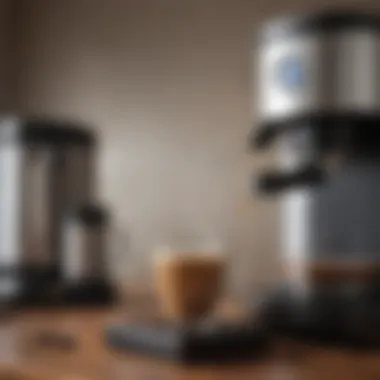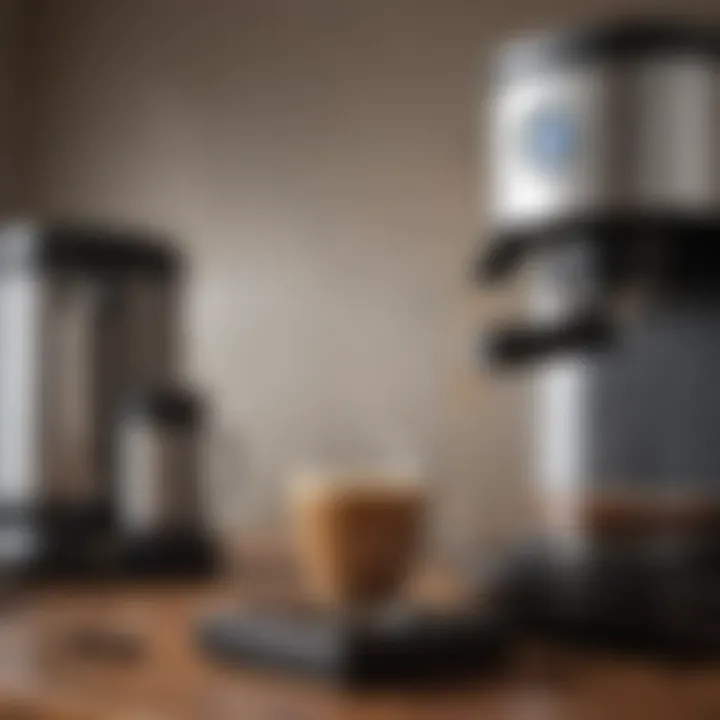A Practical Guide to Cleaning Your Coffee Maker


Intro
Coffee makers play a pivotal role in many households, serving not just the purpose of brewing a steaming cup of coffee but also enhancing the daily routine. However, the importance of regular cleaning is often overlooked. This oversight can lead to unwanted residue buildup, affecting both the machine’s functionality and the flavor of the coffee.
This guide explores why maintaining a clean coffee maker is essential. We will discuss the various cleaning methods available, the frequency of cleaning required, and the potential consequences of neglecting this task. By understanding these elements, coffee enthusiasts and homeowners alike can appreciate the significance of cleanliness in their brewing experience.
Key Points to be Discussed
- Cleaning Methods: Various strategies for effectively cleaning your coffee maker, including both commercial products and DIY solutions.
- Frequency Recommendations: Suggested timelines for cleaning based on usage and machine type, ensuring optimal performance.
- Impact of Residue Buildup: Insights into how leftover coffee oils and mineral deposits can affect taste, aroma, and machine longevity.
- Health Considerations: Understanding the implications of a dirty coffee maker on health, emphasizing the need for regular maintenance.
- Aesthetic Factors: How a clean coffee maker contributes to the overall look of your kitchen or dining area.
Through this comprehensive approach, readers will gain a deep understanding of not only how to clean their coffee makers but also why it matters. A well-maintained machine can transform your coffee experience, making each cup more enjoyable and ensuring that your coffee maker remains a reliable companion for years to come.
Understanding the Importance of Cleaning Your Coffee Maker
Maintaining a clean coffee maker is vital for both the quality of your brew and the longevity of the appliance. Many users overlook the cleaning process, thinking it is unnecessary. However, neglecting this essential task can lead to several problems that affect the overall coffee experience.
Impact on Taste and Aroma
When a coffee maker goes uncleaned for an extended period, it accumulates oils, coffee grounds, and minerals. This buildup can compromise the taste of the coffee, resulting in dull flavors and unwanted aftertastes. Fresh coffee beans provide unique flavors and aromas, but if the machine is dirty, these qualities diminish. Cleaning the coffee maker eliminates residue and allows the coffee to express its true essence. It is important to remember that a clean brew is the first step to an extraordinary coffee experience.
Health Considerations
A coffee maker also serves as a breeding ground for bacteria and mold if it is not cleaned regularly. Water left stagnate within the system creates conditions for harmful microorganisms to thrive. Drinking coffee prepared in a dirty machine amounts to consuming these bacteria. This is not just unpleasant but can pose potential health risks. Regular cleaning helps to ensure that your coffee maker remains sanitary and safe, promoting better health for you and your family.
Prolonging the Appliance Lifespan
Maintaining the coffee maker’s condition is essential for prolonging its lifespan. Over time, mineral deposits from hard water can cause internal components to become clogged and corroded. These issues can result in expensive repairs or even the need for a completely new machine. A proactive cleaning routine preserves the functionality of the coffee maker, ensuring it lasts as long as possible. By prioritizing cleaning, you protect your investment in a quality appliance.
"A clean coffee maker not only enhances flavor but also safeguards health and extends appliance life."
In summary, understanding the reasons behind keeping a coffee maker clean is crucial for any coffee enthusiast. The impact on taste and aroma, considerations for health, and the appliance's lifespan are essential factors that warrant attention. Regular maintenance ensures that coffee lovers can enjoy their favorite brews without compromise.
Types of Coffee Makers and Their Unique Cleaning Needs
The type of coffee maker you use has a profound effect on how you should approach cleaning it. Different designs and brewing methods lead to varying cleaning requirements. Understanding these unique needs is essential for maintaining your coffee maker’s performance and ensuring a high-quality brew.
The considerations for cleaning can impact not just the longevity of your device but also the taste of your coffee. Neglecting proper maintenance based on the type of coffee maker can lead to buildup of minerals and residue that will affect flavor and aroma.
Drip Coffee Makers
Drip coffee makers are very common in households and offices. Their operation makes them susceptible to stains and deposit build-up, primarily due to the use of ground coffee and hot water passing through. Cleaning a drip coffee maker regularly ensures that old oils from the coffee do not impart a bitter taste into your fresh brew.
For drip coffee makers, it is crucial to:
- Clean the carafe after each use to prevent staining.
- Descale the machine at regular intervals to remove mineral deposits, which is especially important in areas with hard water.
- Wipe down the exterior to avoid dust accumulation, which can lead to other issues.
The brewing process in these machines often leaves behind oils that can create an unpleasant aftertaste if not cleaned properly. Regular cleaning should include washing removable parts with warm, soapy water and running a vinegar solution through the machine to ensure a thorough cleanse.
Single Serve Machines
Single serve machines, such as Keurig, provide convenience but also require diligent care. Due to their compact design, they can accumulate coffee residues in various areas, including the needle that punctures the pods. Regular maintenance helps avoid clogs and ensures that the coffee served is fresh and retains its intended flavor.
Key cleaning steps include:
- Cleaning the water reservoir to remove any buildup that may affect the quality of water you brew with.
- Descaling using a suitable descaling solution according to the manufacturer’s recommendations to prevent mineral buildup.
- Removing and cleaning the drip tray regularly, as it can collect water and coffee drips that lead to mold growth.
Maintaining a clean single serve machine ensures that each cup of coffee tastes just as the manufacturer intended, preserving the integrity of flavors.
Espresso Machines
Espresso machines, often viewed as the pinnacle of coffee brewing, have specific cleaning needs due to their complex components. Accumulation of oils from coffee grounds can quickly impact the taste if not addressed promptly. Additionally, these machines may require more advanced cleaning tools and techniques to keep them in optimal working condition.
When cleaning espresso machines, consider:
- Backflushing the machine regularly if it has a three-way valve to eliminate oils from the brew head.
- Cleaning the portafilter and basket after each use to prevent residue build-up.
- Descaling the system every 1–3 months depending on water hardness, as mineral scale can affect performance.
Properly maintaining an espresso machine ensures that it operates effectively and produces rich, flavorful espresso shots that coffee enthusiasts crave. Each type of coffee maker has distinctive cleaning requirements, and attentiveness to these specifics will provide better tasting coffee and prolong the life of your machine.
"Cleaning your coffee maker is not just about maintenance; it’s about enhancing your daily ritual."
Recognizing Signs That Your Coffee Maker Needs Cleaning
Cleaning your coffee maker is essential for maintaining its performance and ensuring the best flavor in your brewed coffee. However, knowing when to clean it can be tricky. Recognizing the signs that indicate a need for cleaning is crucial for any coffee enthusiast. Ignoring these signs can lead to poor tasting coffee, potential health issues, and even damage to the machine itself. It is important to be observant and proactive about maintenance to enjoy an optimal coffee experience.
Changes in Brew Time
One of the first indicators that your coffee maker may need cleaning is a noticeable change in brew time. If you find that your coffee is taking longer to brew than usual, this can signal a buildup of mineral deposits or coffee residue within the machine. Over time, scale can form and restrict the flow of water through the system, leading to an inefficient brewing process.
When this happens, the hot water cannot circulate properly, affecting the extraction of flavors from the coffee grounds. The outcome might be undesirable and can result in a less satisfying cup of coffee. It is wise to keep a close eye on the brew time. If it significantly increases, it's time to undertake a thorough cleaning.
Unusual Tastes or Odors


Another major sign that your coffee maker requires cleaning is the presence of unusual tastes or odors in your brew. If your coffee starts to taste bitter, sour, or otherwise off, that is often a direct result of residue buildup. Grease and old coffee oils can accumulate over time, tainting the flavor of fresh brews. You might also notice a strange smell coming from the machine during or after brewing.
These unpleasant tastes and odors can be particularly off-putting, especially if you take your coffee seriously. Regular cleaning can help avoid these issues, ensuring that each cup is fresh and flavorful. When you detect a change in taste or smell, it's a clear signal to perform a cleaning ritual.
Visible Residue or Build-Up
Lastly, visible residue or build-up is a straightforward sign that cleaning is overdue. If you see dark stains, oily films, or any other kind of residue in the coffee maker's components, it indicates neglect. This build-up can be located in various parts such as the carafe, filter basket, or even inside the brewing chamber.
When left unattended, this residue can spoil the flavor of your coffee and create a breeding ground for bacteria. Regular inspection of these areas will help identify any build-up early on. Cleaning should be done promptly to maintain hygiene as well as coffee quality.
Keeping your coffee maker clean is not just about aesthetics; it is essential for the tasteful extraction of your beans.
Basic Cleaning Supplies for Your Coffee Maker
Cleaning your coffee maker requires the right supplies. These tools are essential to maintain the coffee maker’s performance and ensure drinks are tasty. Having the proper cleaning supplies can prevent residue buildup, which affects both the machine and the coffee taste.
Vinegar and Water Solution
One of the most effective and economical cleaning solutions is a mixture of vinegar and water. Vinegar acts as a natural disinfectant, effectively removing mineral deposits and buildup that can accumulate inside the coffee maker. To create this solution, mix equal parts of vinegar and water, then run this mixture through a brewing cycle. This not only cleans the internal components but also helps neutralize odors that may linger in the machine. After running the cycle, it is crucial to follow with a few cycles of plain water to rinse out any remaining vinegar residue.
Baking Soda for Tough Stains
Baking soda serves as an excellent option for tougher stains or grime that can develop on the coffee maker's exterior or carafe. To use baking soda, create a paste by mixing water and baking soda. Apply this paste to stained areas and let it sit for a few minutes before scrubbing gently with a cloth or sponge. This method targets those stubborn stains without causing damage to the materials of your coffee maker. It is effective in ensuring that the aesthetics of your machine are maintained while also enhancing its cleaning function.
Commercial Cleaning Products
When simple solutions like vinegar and baking soda are not adequate, many look to commercial cleaning products specifically designed for coffee makers. These products are often highly effective and convenient for busy individuals.
Choosing the Right Product
Choosing the right commercial cleaning product can greatly influence the cleaning process's success. Effective products should target residue and buildup while being safe for the specific type of coffee maker. Typically, these products include natural ingredients that facilitate easier cleaning. Another essential factor is ensuring compatibility with your specific model, as some machines may require unique formulations.
Understanding Ingredients
It is important to comprehend the ingredients used in these commercial cleaners. Many products consist of specific acids and surfactants that react with mineral deposits. Understanding what these ingredients do can help avoid products that may potentially damage your coffee maker. Look for products with fewer harsh chemicals, particularly if you are cautious about what goes into your drinks. Being aware of these elements ensures that you clean effectively, without compromising the machine's integrity.
"Regular cleaning of your coffee maker not only improves coffee flavor but also extends the life of the appliance."
In essence, having quality cleaning supplies makes all the difference in the maintenance of your coffee maker. Whether you opt for home remedies or commercial products, each choice contributes significantly to the overall functionality of the appliance.
Step-by-Step Cleaning Process for Coffee Makers
Cleaning a coffee maker is not merely a maintenance task; it is essential for ensuring the quality of the brew and the longevity of the machine. This section will lay out a detailed approach to cleaning your coffee maker. Through a systematic process, you can eliminate residual oils, mineral deposits, and bacteria that can affect taste and health. Following these steps will result in a well-functioning appliance and a better coffee experience.
Preparing for Cleaning
Before you begin the cleaning process, gather all your supplies. This should include:
- White vinegar
- Water
- Baking soda (for stubborn stains)
- A soft cloth or sponge
- A soft brush for hard-to-reach areas
Understanding the proper preparation steps can set a positive tone for the cleaning process. Ensure the coffee maker is unplugged and cooled down. This is necessary for safety and to prevent burns. If the machine has any removable parts, such as the carafe or filter, remove them to facilitate thorough cleaning.
Tip: It can be helpful to read your coffee maker’s manual for any specific cleaning recommendations.
Cleaning the Carafe and Components
The carafe typically retains coffee oils and stains, which can alter the flavor of future brews. Start by washing the carafe with warm, soapy water. If there are stubborn stains, add baking soda to the water. Let it soak for a few minutes. This step will help lift any residues stuck to the glass.
For other components like the filter basket, rinse it under warm water to remove ground coffee remnants. Ensure these parts are dried completely before reassembling.
- Use a soft cloth to wipe down the exterior of the coffee maker, cleaning areas that may attract dust and grime.
- Do this frequently to keep your machine looking new.
Descaling the Inner Mechanisms
Descaling your coffee maker is crucial, especially if you live in an area with hard water. Hard water can leave behind mineral deposits that accumulate over time and impede the machine's performance. To descale, prepare a solution of equal parts white vinegar and water.
- Fill the water reservoir with the solution.
- Start a brewing cycle without coffee grounds.
- Once this cycle completes, let the machine sit for about 15-30 minutes. This allows the solution to loosen any scale buildup.
- Finish the brewing cycle.
- Rinse the reservoir thoroughly by running two to three cycles of plain water.
Regular descaling not only improves the taste of your coffee but extends the life of your appliance.
By adhering to these detailed steps, you ensure your coffee maker remains in optimal condition, contributing to your enjoyment of coffee while also protecting the health aspects related to clean appliances. Regular cleaning will transform the way you experience your daily brew.
Frequency of Cleaning: How Often Should You Clean Your Coffee Maker?
Cleaning your coffee maker is not just a matter of preference; it is essential for optimal performance and taste. A regular cleaning schedule ensures that your brewing equipment does not become a hotspot for bacteria and mineral buildup. By understanding how often you should clean your coffee maker, you can enhance the quality of your coffee, protect your health, and extend the lifespan of your appliance.
Daily Maintenance Tasks
Daily maintenance is the foundation of a clean coffee maker. Here are key tasks that you should adopt:
- Empty and Rinse the Carafe: After each use, remove the carafe and rinse it with warm water. This prevents any coffee residue from hardening, which can affect the flavor of your next brew.
- Clean the Brew Basket: If your machine has a removable filter basket, wash it with warm soapy water. Even if you use disposable filters, oils from coffee grounds can accumulate.
- Wipe Down the Exterior: Finally, don’t neglect the exterior. A quick wipe with a damp cloth helps keep your machine looking new and hygienic.
Performing these simple tasks daily can contribute significantly to the overall maintenance of your coffee maker.


Weekly Cleaning Routines
A weekly cleaning routine is vital for deeper cleaning tasks that go beyond the daily checklist. Consider including the following into your routine:
- Run a Clean Cycle: Many models come with a clean cycle or a descaling setting. Use a mixture of equal parts water and white vinegar and run this through the machine to remove mineral buildup.
- Soak Components: Some components, like the drip tray or other removable parts, benefit from soaking in hot soapy water for a few hours. This helps dissolve any residual buildup that accumulates over time.
- Check Water Reservoir: Inspect the water reservoir for any algae or sediment. Clean it thoroughly and wipe it down with a mild detergent if needed.
Incorporating these weekly tasks helps maintain the condition of your coffee maker and enhances the quality of your brews consistently.
Monthly Deep Cleaning Guidelines
Monthly deep cleaning is crucial for those who truly value their coffee experience. Such cleaning might involve:
- Deep Descaling: Use a specialized descaler solution designed for coffee makers. This penetrates deeper than vinegar and removes stubborn limescale that can affect the flavor.
- Inspect Internal Parts: If you are comfortable doing so, open your coffee maker (following the manufacturer's instructions) and inspect the internal parts for excessive buildup. This ensures that all mechanisms function smoothly.
- Filter Replacement: If your machine uses a water filter, check its condition. Most filters need replacing every 2-3 months, but specific brands, like Brita or AquaPure, may have different timelines.
Regular adherence to these monthly guidelines will ensure that your coffee maker functions at peak performance, keeps tasting fresh, and serves you well, no matter your preferred brewing method.
"Inconsistent cleaning affects the flavor and quality of your coffee, leading to a less enjoyable experience for coffee lovers."
Adopting a structured cleaning schedule based on these guidelines will lead to a better coffee experience and increased longevity of your coffee maker. Regular attention to cleanliness not only enhances taste but also resonates with home aesthetics, reflecting a thoughtful approach to daily brewing rituals.
Special Considerations for Hard Water Areas
When it comes to cleaning your coffee maker, the water you use can play a significant role, especially in hard water areas. Hard water contains a high concentration of minerals like calcium and magnesium. Over time, these minerals can cause limescale buildup in your coffee maker. This not only affects the performance of the machine but also impacts the taste of the coffee brewed. Understanding how hard water affects your coffee maker is crucial for your maintenance practices.
Understanding Hard Water Impact
The consequences of hard water on your coffee maker can be quite detrimental. The buildup of limescale can obstruct water flow, leading to longer brew times. This limescale can also affect the heating elements of the coffee maker, causing it to work harder and consume more energy. As limescale accumulates, it can also lead to inconsistent brewing temperatures, which can alter the taste of your coffee. Regular descaling becomes essential in such situations to ensure your coffee makers function effectively.
Recommended Water Filtration Solutions
To mitigate the negative impacts of hard water, implementing water filtration solutions is advisable. Using filtered water can significantly reduce mineral content while preserving essential flavors. Consider investing in water filters that are compatible with your faucet, such as Brita or PUR. Another option is to use a water softener, which can help reduce the hardness of your water supply. Additionally, using bottled spring water is a practical immediate solution for brewing while also ensuring that your coffee tastes balanced and fresh.
Additional Descaling Frequency Advice
In areas where hard water is prevalent, descaling your coffee maker should be done more frequently than standard recommendations. Instead of the usual monthly guideline, consider descaling every two to three weeks. If you're in a location with extremely hard water, it might be worth assessing your needs on a weekly basis. Maintain a close eye on performance indicators such as brew time and taste, adjusting your cleaning routine accordingly. Keeping a regular descaling schedule will help prolong the lifespan of your appliance while ensuring that your coffee remains rich and enjoyable.
"Regular maintenance and mindful choices in water usage can profoundly impact the quality and longevity of your coffee maker."
Utilizing these strategies places you in a better position to fully enjoy the coffee brewing experience without the interference of hard water issues.
Troubleshooting Common Coffee Maker Cleaning Issues
Cleaning your coffee maker is crucial to maintain the optimal functionality of this appliance. However, even with regular cleaning, issues may arise that could affect the overall experience of brewing coffee. Understanding these common problems—such as persistent odors, off tastes, and mechanical clogs—can be essential for coffee enthusiasts. Troubleshooting these issues can lead to better tasting coffee, improved equipment longevity, and a continued enjoyment of the coffee brewing process.
Persistent Odors After Cleaning
Persistently unpleasant odors after cleaning can be frustrating. Even when the coffee maker is thoroughly cleaned, lingering smells might persist. This situation often indicates that residues have not been entirely removed.
To remedy this, first ensure that you are using the correct cleaning solutions, like vinegar. Run a mixture of equal parts vinegar and water through the brewing cycle.
- Follow this with a couple of cycles using just plain water to flush out any residual vinegar smell.
- Inspect the coffee pot and filter basket for remaining coffee oils or residues, and clean them thoroughly.
Also, ensure that you allow all components to air dry after cleaning, as moisture can lead to mildew growth, which emits an offensive odor.
Coffee Tastes Off Despite Cleaning
Experiencing an off or strange taste in coffee, even after cleaning, can be an inconvenience for many. This issue most often arises due to the buildup of oils or residues that are not easily removed by standard cleaning methods.
To address this:
- Consider doing a deep clean. Soak the water reservoir and all detachable parts in a mixture of water and vinegar overnight to thoroughly break down accumulated oils.
- Another effective method is using baking soda. Create a paste with water and scrub any areas that seem discolored or stained.
If these methods do not yield results, it might be worth exploring the quality of your water; mineral content in the water can also affect taste.
Clogs and Blockages
Clogs are a frequent issue in coffee makers, often arising from mineral buildup, especially in areas exposed to water.
To prevent and resolve clogs:
- Regularly descale your coffee maker using a commercial descaler or a vinegar solution. Run the descaling solution through the machine and allow it to sit for at least 30 minutes.
- After descaling, run several cycles of clean water to ensure that any residue is fully washed away.
- Pay attention to the filter basket and spout, as these are common sites for blockages. Regularly check and clean these areas to avoid issues.
By understanding and addressing these common cleaning issues, you can enjoy a clean and efficient coffee maker that consistently delivers quality brews. Regular maintenance and a proactive troubleshooting approach will ensure that coffee making remains a joyful experience.
Sustainable Practices in Coffee Maker Maintenance
Sustainable practices in coffee maker maintenance contribute significantly to both the environment and the quality of your coffee. As awareness of environmental issues grows, consumers increasingly seek ways to reduce their ecological footprint. Implementing sustainable practices in maintaining your coffee maker offers various benefits, including cleaner coffee, less waste, and better resource management.
Eco-Friendly Cleaning Products
When choosing cleaning products for your coffee maker, consider eco-friendly options. These products minimize the use of harmful chemicals and often include natural ingredients. You can find alternatives like vinegar or baking soda, which are effective in maintaining a clean coffee maker without endangering the environment. These solutions are biodegradable, making them safer for disposal.
By choosing eco-friendly cleaning products, you also ensure that the coffee you brew remains free of any chemical residues. This decision not only benefits your health but also contributes to a more sustainable coffee-making process.


Reducing Waste in Coffee Preparations
Reducing waste in coffee preparations can be achieved through simple changes in habits. One way to do this is to opt for reusable coffee filters instead of disposable ones. Reusable filters are durable and can significantly cut down on waste generated from single-use items. Additionally, consider composting used coffee grounds, which can serve as a natural fertilizer for plants.
Another sustainable approach is to measure the coffee and water carefully to minimize leftover brewed coffee. This practice can prevent waste, allowing you to enjoy your coffee without excess. Attention to portion size also ensures that you avoid unnecessary waste during each brew.
Recycling Old Coffee Makers
If your coffee maker reaches the end of its lifespan, recycling it properly is essential. Many components of coffee makers can be broken down and repurposed. Check for local recycling programs that accept electronic waste; many municipalities have designated drop-off locations for such items.
Before discarding your coffee maker, remove any non-recyclable materials like plastic or filters. This ensures that maximum parts are processed sustainably. By recycling old appliances, not only do you reduce waste in landfills but you also contribute to the circular economy, promoting the use of reclaimed materials in new products.
By embracing sustainable practices in coffee maker maintenance, you can enjoy your daily brew while minimizing your impact on the environment.
Advanced Cleaning Techniques for Coffee Enthusiasts
Advanced cleaning methods can bring a significant enhancement to the durability and performance of your coffee maker. For coffee enthusiasts, the ultimate goal is not just to enjoy a good cup of coffee but to ensure each brew is fresh and flavorful. Regular maintenance may suffice for casual users, but advanced techniques address more persistent problems and ensure thorough cleaning.
Using specialized descaling tools or opting for professional cleaning services can provide a deeper cleanse than standard methods. Moreover, these approaches can eliminate underlying issues that might not be easily noticed, such as hidden buildup or mineral deposits. Understanding these cleaning options not only improves the taste of coffee but also emphasizes the responsibility of maintaining one’s equipment with care.
Using Specialized Descaling Tools
Specialized descaling tools are designed specifically to combat mineral buildup in coffee makers. They often contain stronger, more effective ingredients than standard solutions, making them particularly useful in areas with hard water.
These tools are available in various formulations, either as powders or liquids. To use, follow these steps:
- Check Manufacturer's Instructions: Always begin by referring to the coffee maker's manual for specific recommendations regarding descaling tools.
- Prepare the Solution: Mix the descaling agent with water in the proportions suggested by the manufacturer.
- Fill Reservoir: Pour this solution into the coffee maker's water reservoir, just like preparing for a regular brew.
- Run a Brew Cycle: Start a brew cycle, allowing the solution to circulate through the system.
- Rinse Thoroughly: After the cycle ends, run a few cycles with plain water to rinse away any residual cleaner.
This process is essential for maintaining optimal functionality. It can prevent coffee from tasting bitter or off, which is a common complaint among frequent users. Furthermore, implementing specialized descaling enhances the lifespan of the coffee machine, making it a wise investment in your coffee culture.
Professional Cleaning Services
If you find that your coffee machine is still not performing as expected after attempting to maintain it yourself, professional cleaning services may be warranted. Professional technicians have access to advanced tools and cleaning solutions that can delve into hard-to-reach areas, removing buildup that home methods might miss.
Some benefits of using professionals include:
- Deep Cleansing: Their expertise allows for a more thorough cleanse. They can address stubborn deposits that impact both taste and performance.
- Time Savings: If you have a busy schedule, hiring a professional allows you to continue your routines without the interruption of extensive cleaning tasks.
- Maintenance Tips: Professionals often provide tailored advice on how to improve your coffee maker's lifespan based on their evaluations of your machine.
Professional cleaning may be an extra expense, but for enthusiasts who rely on their coffee makers for daily use, it can prove a valuable investment. Maintaining a coffee maker at peak performance is not a trivial task; it takes dedication and sometimes the assistance of experts.
Regular cleaning not only preserves the flavor of your coffee but also enhances the longevity of your machine, making it a crucial part of your coffee routine.
Exploring Alternatives: Non-Electric Coffee Brewing Methods
Non-electric coffee brewing methods offer unique benefits and experiences for coffee enthusiasts. They can foster a deeper appreciation for the art of coffee preparation and provide alternatives when electric coffee makers are not available or practical. These methods often require more manual effort and attention, but they can yield coffee that many drinkers find more satisfying in terms of flavor and aroma.
Moreover, non-electric methods tend to be more portable and sustainable. For those who travel or camp, these brewing options eliminate the need for electricity, making them ideal companions on outdoor adventures. Additionally, they often involve less electronic waste, aligning well with sustainable living practices. Familiarizing oneself with these alternatives not only enhances one’s coffee repertoire but also aligns with a growing lifestyle trend prioritizing simplicity and minimalism.
French Press Techniques
The French press, also known as a cafetière, is a popular choice for brewing coffee without electricity. The principle behind this method is straightforward: coarsely ground coffee is steeped in hot water, allowing the oils and flavors to be extracted before pressing down the plunger to separate the grounds from the liquid.
To use a French press effectively:
- Start with coarsely ground coffee. About two tablespoons per cup of water is a common ratio.
- Boil water and let it cool for around 30 seconds to reach the ideal temperature, about 200°F (93°C).
- Pour the hot water over the coffee grounds, then stir gently.
- Place the lid on the French press and allow the coffee to steep for four minutes.
- Slowly press the plunger down to separate the coffee from the grounds.
- Serve immediately to enjoy the best flavor.
The French press method allows for rich flavors and a full-bodied brew. However, it requires attention to brewing time to avoid over-extraction, which can lead to bitterness. Regular cleaning of the French press is also essential to prevent residue buildup from affecting future brews.
Pour-Over Brewing Methods
Pour-over brewing is another alternative that emphasizes control and precision. This method involves manually pouring hot water over coffee grounds, allowing for even saturation and extraction. It is favored for its clean taste and the ability to highlight the unique characteristics of different coffee beans.
To execute a pour-over method effectively:
- Place a filter in the dripper and add ground coffee to the filter. A medium grind is generally recommended.
- Heat water to the appropriate temperature. Again, around 200°F (93°C) is optimal.
- Slowly pour a small amount of water over the coffee grounds to let them bloom. This takes about 30 seconds.
- Continue pouring the water in circular motions to evenly saturate the grounds.
- Allow the water to drip through the coffee into the carafe or cup below.
The pour-over method requires practice to perfect, with the right timing and pouring technique impacting the final taste. The result is a clean and vibrant cup of coffee, and like the French press, requires proper maintenance to ensure flavor is not compromised by leftover oils or grounds.
End
Cleaning your coffee maker is more than a routine task; it is essential for maintaining the quality and longevity of your appliance. A clean coffee maker contributes to superior taste and aroma, ensuring that each cup of coffee you brew is enjoyable. Additionally, regular maintenance has health implications; it limits bacterial growth and mineral buildup that can affect the safety of your beverages.
Moreover, caring for your coffee maker can prolong its lifespan. Many users overlook this aspect, but neglecting proper cleaning can lead to wear over time, forcing you to replace your machine sooner than necessary.
Finalizing your cleaning routine will benefit you in several ways:
- Ensures consistent flavor in your coffee.
- Reduces health risks associated with residue.
- Saves money by extending your coffee maker’s life.
- Enhances your daily brewing experience.
"Regular maintenance is not just good practice but crucial for coffee enthusiasts."
Recap of Key Points
In this guide, we have covered several important aspects:
- The significance of cleaning your coffee maker for taste, health, and longevity.
- The unique cleaning needs based on different types of coffee makers, like drip machines and espresso systems.
- Identifying signs that your coffee maker requires cleaning, such as changes in brew time and unusual smells.
- Suggested cleaning supplies, including vinegar, baking soda, and commercial cleaning products.
- Step-by-step instructions for effectively cleaning your coffee maker and its components.
- Recommended cleaning frequency to maintain optimal performance.
- Special considerations for hard water areas and its impact on maintenance.
- Troubleshooting common cleaning issues that may arise.
- Sustainable practices for eco-friendly maintenance.
- Advanced techniques for dedicated coffee lovers.
Final Thoughts on Maintenance
As you integrate these cleaning practices into your routine, consider not only your coffee maker's performance but also your health and environmental impact. Keep in mind that the goal is to enjoy every cup and to foster a mindful approach to the tools you use for your coffee. When you treat your coffee maker with respect through regular cleaning, it will consistently reward you with delightful beverage experiences.







